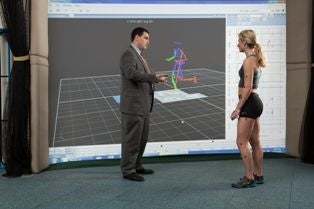In Foxborough, where the New England Patriots play, Mass General Hospital has just opened an innovative sports treatment center that its head doctor says will help athletes recovery more quickly and avoid reinjury.
The Mass General Orthopaedics Sports Performance Center, which opened this month, is geared to treat injuries ranging from those a professional linebacker might suffer to those you might find in a hobbyist golfer or youth sports athlete.
The Boston-based research hospital has been a presence next to Gillette stadium since 2009, when it opened its Brigham and Women’s/Mass General Health Care Center at the mixed-use retail, dining and entertainment complex known as Patriot Place. The sports center is now located in that facility.
The center is led by Dr. Eric Berkson, the team physician for the Boston Red Sox. He said the Sox have asked him not to comment about whether the team might avail itself of the center’s services.
Berkson said Mass General already had teams of specialists in sports medicine, physical therapy and performance training. The center is an effort to combine those areas, which makes it unique, he said.
“This really grew out of some clinical questions we had as sports medicine specialists,” Berkson explained. “How can we get our patients back to sports better, faster and more efficiently?”
It turns that in additional to clinical expertise, technology is a big piece of the answer.
Movie Technology Spawns Medical Innovation
The same sort of technology used by the makers of movies like Avatar and various video games inspired the medical equipment that adorns the inside of the sports center in Foxborough, Berkson said.
Patients don a series of markers on their bodies that measure speed and force across the joints in the body. The movement translates into a type of three-dimensional moving x-ray on a nearby screen that helps the center’s doctors and staff figure out if an athlete is performing a motion improperly and also help patients modify their motion to avoid reinjuring themselves. It can also come in handy for optimiziming motion in uninjured athletes.
Berkson said the technology, known as 3-D biomechanical imaging, helps answer the question: “What compensatory mechanisms are you using because of injuries you’ve had?”
“We can now look into what’s happening from a functional standpoint with someone’s recovery from an injury or looking to prevent an injury or looking to optimize an activity,” he said.

